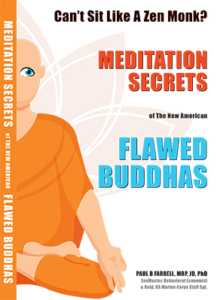Last Updated on March 19, 2021 by Paul Farrell, MRP, JD, PhD

Centering prayer… Neurosciences trigger renewal of “fire in the soul” with gentle refocusing on a “sacred word!”
A young monk came up to the great Zen master Dogen and excitedly explained that when he was deep in his meditation the Buddha came to him surrounded in a brilliant white light.
Dogen responded: ‘That’s nice. Now just focus on your breathing and it will go away’.”
– Zen wisdom
Dr. Joan Borysenko is a psychotherapist and cell biologist. She is one of the leaders in the emerging science of psychoneuroimmunology – the study of how our thinking and behavior interact with our nervous and immune systems and ultimately affects our physical health. In Fire in the Soul, Borysenko says that “after many years of practicing different forms of meditation I settled into the practice of centering prayer, which I also like to teach because of its clarity, simplicity and effectiveness.”
Put this in context: Remember that back in the seventies meditation of any kind, let alone a new field with an esoteric name like psychoneuroimmunology, was a radical departure from traditional medicine, which focuses primarily on sickness, physical diseases and pathologies, and relies primarily on drugs and surgery in healing the body’s ailments.
Spiritual Optimism is Focusing on a Sacred Word
Borysenko, along with Benson, Kabat-Zinn and others in the new field of stress management were shifting their focus from disease and sickness to wellness and health – to what she calls “spiritual optimism,” wellness and a positive approach to life crises and problems, looking at them as opportunities for personal growth and shift to the spiritual.
The great philosopher and theologian Pierre Teilhard de Chardin once described this shift in very simple terms:
“We are not human beings having a spiritual experience, we are spiritual beings having a human experience.”
Centering meditation is a perfect expression of this new spirit of optimism and positive thinking says Borysenko: It “involves the repetition of a sacred word chosen by the meditator, its focus is not on the sacred work per se, but on the inner silence. The word – which can be as simple as ‘peace,’ ‘shalom,’ ‘Jesus,’ ‘let go,’ or any other pleasing focus—is not repeated continually, but as a reminder to return to the silence when the mind begins to wander.”
The practice of centering has deep roots in the ancient contemplative lives of Christian mystics such as St. John of the Cross and St. Teresa of Avila. Over the centuries contemplative living took many forms. In Ram Dass’ Journey of Awakening: A Meditator’s Guidebook, we learn that “reading scriptures, praying, and communing with nature were all forms of contemplation” by all mystics, East and West. Today we see how it has evolved in the Catholic mass.
Simple Guidelines Make Centering Work
Centering prayer was refined in the seventies by Fr. Thomas Keating, a Trappist monk. In fact, Borysenko says that Keating’s book, Open Mind, Open Heart: The Contemplative Dimension of the Gospel, is “the single best book about meditation.” In Keating’s meditation the object of focus is the “divine presence.” A set of simple guidelines for centering meditation were included in a recent Spirituality & Health magazine interview with Fr. Keating:
“Choose a sacred word as a sign of your intention to consent to God’s presence and action within. Choose a word during a brief prayer asking for the Holy Spirit to inspire you with one suitable for you, such as Lord, Abba, father, mother, amen, love, peace, or shalom.
Sit in a comfortable position with eyes closed.
Settle into your silence.
Choose a sacred word as a sign of your consent to God’s presence and action within.
Whenever you become aware of thoughts, gently return to the sacred word.
At the end of the prayer, remain silent with eyes closed for a few minutes.
Two periods of twenty minutes each day are recommended, one first thing in the morning and one in the afternoon or early evening.”
And that’s it, the process of centering prayer and meditation is that simple. And I urge you to read Fr. Keating’s book to learn more about how to make centering meditation a part of your everyday living.
Touch the “Divine Presence” Within You – And the Whole World
According to Borysenko this focus on the “divine presence” is what sets centering meditation apart from most other meditation methods – including body-centered meditations where “the focus phrase or mantra may be repeated either in rhythm with the breathing as suggested by Dr. Herbert Benson in The Relaxation Response, or without reference to breathing, as in transcendental meditation, as taught by the Maharishi Mahesh Yogi” and in the sitting meditation practices of Tibetan Buddhist monks.
Similarly, in Open Mind, Open Heart, Fr. Keating also distinguishes centering meditation by specifically mentioning that it is not a “relaxation exercise,” nor self-hypnosis, nor a way to induce a high, nor a paranormal experience, and interestingly, he also says centering prayer is not a “mystical phenomenon.”
When Keating adds that “even saints have misunderstood what God said to them,” I was reminded of a wonderfully amusing little story often repeated for monks in training. A young monk came up to the great Zen master Dogen and excitedly explained that when he was deep in his meditation the Buddha came to him surrounded in a brilliant white light. Dogen smiled:
“How nice. Now just focus on your breathing and it will go away.”
A Gentle Down-To-Earth Spirituality
Centering meditation has that same natural spirituality about it. Yes, the focus is on a word that expresses the divine presence in your life. Yes, you pick a sacred word rather than focusing on your breathing or repeating a mantra in an inconsequential language.
And yet, there is universal quality in Keating’s emphasis, a quality that oddly (although he says otherwise) seems to drawn in and embrace the physical, mental and psychological aspects of life as part of this universal spirituality.
Indeed, as Keating puts it, centering meditation or contemplative prayer
“is not so much the absence of thoughts as a detachment from them. It is the opening of the mind and heart, body and emotions – our whole being – to God, the Ultimate Mystery, beyond words, thoughts and emotions – beyond, in other words, the psychological content of the present moment. We do not deny or repress what is in our consciousness. We simply accept the fact of whatever is there and go beyond it, not by effort, but by letting go of whatever is there,”
a belief that is engrained in centuries of Taoist and Buddhist thought.
About the Author
Dr. Farrell is a Behavioral Economist. His books include The Millionaire Code; The Millionaire Meditation: Stress Management for Wall Street, Corporate America & Entrepreneurs; The Zen Millionaire; The Winning Portfolio; Expert Investing on The Net; Mutual Funds on The Net; and The Lazy Person’s Guide to Investing.
He also published 1,643 columns on DowJones-MarketWatch and for years was their #1 traffic-generating columnist. Before the Internet, he edited & published FNX: Future News Index, a financial newsletter for stock market traders. Earlier he was a Wall Street investment banker with Morgan Stanley, Executive Vice President of the Financial News Network; and Associate Editor of the Los Angeles Herald Examiner.
He has a Doctorate in Psychology, Juris Doctor, Masters in Regional Planning and Bachelor of Architecture. He worked on the Esalen organic farm and served in the U.S. Marine Corps as Staff Sergeant in aviation computer technology.








